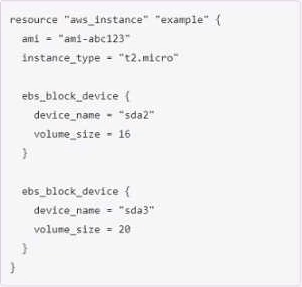HashiCorp TA-003-P HashiCorp Certified: Terraform Associate (003) Online Training
HashiCorp TA-003-P Online Training
The questions for TA-003-P were last updated at Dec 20,2025.
- Exam Code: TA-003-P
- Exam Name: HashiCorp Certified: Terraform Associate (003)
- Certification Provider: HashiCorp
- Latest update: Dec 20,2025
What information does the public Terraform Module Registry automatically expose about published modules?
- A . Required input variables
- B . Optional inputs variables and default values
- C . Outputs
- D . All of the above
- E . None of the above
You must use different Terraform commands depending on the cloud provider you use.
- A . True
- B . False
As a member of an operations team that uses infrastructure as code (lac) practices, you are tasked with making a change to an infrastructure stack running in a public cloud.
Which pattern would follow laC best practices for making a change?
- A . Make the change via the public cloud API endpoint
- B . Clone the repository containing your infrastructure code and then run the code
- C . Use the public cloud console to make the change after a database record has been approved
- D . Make the change programmatically via the public cloud CLI
- E . Submit a pull request and wait for an approved merge of the proposed changes
You ate making changes to existing Terraform code to add some new infrastructure. When is the best time to run terraform validate?
- A . After you run terraform apply so you can validate your infrastructure
- B . Before you run terraform apply so you can validate your provider credentials
- C . Before you run terraform plan so you can validate your code syntax
- D . After you run terraform plan so you can validate that your state file is consistent with your infrastructure
How would you reference the volume IDs associated with the ebs_block_device blocks in this configuration?

- A . aws_instance.example.ebs_block_device[sda2,sda3).volume_id
- B . aws_lnstance.example.ebs_block_device.[*].volume_id
- C . aws_lnstance.example.ebs_block_device.volume_ids
- D . aws_instance.example-ebs_block_device.*.volume_id
Which command should you run to check if all code in a Terraform configuration that references multiple modules is properly formatted without making changes?
- A . terraform fmt -write-false
- B . terraform fmt -list -recursive
- C . terraform fmt -check -recursive
- D . terraform fmt -check
What kind of configuration block will create an infrastructure object with settings specified within the block?
- A . provider
- B . state
- C . data
- D . resource
What is the Terraform style convention for indenting a nesting level compared to the one above it?
- A . With a tab
- B . With two spaces
- C . With four spaces
- D . With three spaces
You have never used Terraform before and would like to test it out using a shared team account for a cloud provider. The shared team account already contains 15 virtual machines (VM). You develop a Terraform configuration containing one VM. perform terraform apply, and see that your VM was created successfully.
What should you do to delete the newly-created VM with Terraform?
- A . The Terraform state file contains all 16 VMs in the team account. Execute terraform destroy and select the newly-created VM.
- B . Delete the Terraform state file and execute terraform apply.
- C . The Terraform state file only contains the one new VM. Execute terraform destroy.
- D . Delete the VM using the cloud provider console and terraform apply to apply the changes to the Terraform state file.
When do changes invoked by terraform apply take effect?
- A . After Terraform has updated the state file
- B . Once the resource provider has fulfilled the request
- C . Immediately
- D . None of the above are correct
Latest TA-003-P Dumps Valid Version with 138 Q&As
Latest And Valid Q&A | Instant Download | Once Fail, Full Refund

